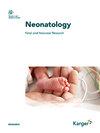母体和围产期因素对新生儿心电图的影响
IF 3
3区 医学
Q1 PEDIATRICS
引用次数: 0
摘要
心肌发育在出生时仍处于过渡阶段,使心肌细胞容易受到母体和围产期因素的影响。我们的目的是调查产妇和围产期因素对新生儿心电图的影响。方法:在一项前瞻性队列研究中,新生儿(0-30天)通过心电图和超声心动图进行心脏评估。评估了医学和人口统计数据、妊娠和出生相关因素以及心电图参数之间的关联。结果:超声心动图正常的单胎15928例,其中男孩52%。根据孕产妇/围产期因素累积数(0、1、2、3、4、≥5)将新生儿分组,分析心电图参数组间差异。我们观察到QRS轴左移和QT延长的加性效应(均p < 0.01)。比较极端组(0 vs.≥5个孕产妇/围产期因素),我们发现QRS轴左移增加4.3% (117 vs. 112°,p < 0.001), QTcFridericia延长0.8%;363 vs 366 ms, p < 0.001);对QTcF的影响在出生后第一周的新生儿中最为明显(360 vs. 368 ms, p < 0.0001)。结论:我们观察到母亲和围产期因素对新生儿心电图参数的累积影响,包括QRS轴更左移和QT持续时间增加,尽管变化在正常参考范围内。我们的研究结果增加了对新生儿心脏过渡和孕产妇/围产期因素的心脏影响的认识。本文章由计算机程序翻译,如有差异,请以英文原文为准。
The Impact of Maternal and Perinatal Factors on the Neonatal Electrocardiogram
Introduction: Myocardial development is still transitioning by the time of birth making the cardiomyocyte vulnerable to maternal and perinatal factors. We aimed at investigating the impact of maternal and perinatal factors on the neonatal electrocardiogram. Methods: In a prospective cohort study, neonates underwent cardiac evaluation with electrocardiograms and echocardiograms (age 0–30 days). Associations between medical and demographic data, pregnancy, and birth-related factors, and electrocardiographic parameters were assessed. Results: A total of 15,928 singletons with normal echocardiograms were included (52% boys). Neonates were divided into groups by accumulated number of maternal/perinatal factors: 0, 1, 2, 3, 4, and ≥5, and between-group differences in electrocardiographic parameters were analysed. We observed an additive effect with a leftward shift of the QRS axis and QT prolongation (all p < 0.01). Comparing extreme groups (0 vs. ≥5 maternal/perinatal factors), we found a 4.3% more left-shifted QRS axis (117 vs. 112°, p < 0.001) and a 0.8% prolonged QTcFridericia (QTcF; 363 vs. 366 ms, p < 0.001); the effect on QTcF was most pronounced in neonates examined in the first week of life (360 vs. 368 ms, p < 0.0001). Conclusion: We observed a cumulative effect of maternal and perinatal factors on neonatal electrocardiographic parameters, including a more left-shifted QRS axis and increased QT duration, although the variation was within normal reference ranges. Our findings add to the knowledge on the neonatal cardiac transition and the cardiac effect of maternal/perinatal factors.
求助全文
通过发布文献求助,成功后即可免费获取论文全文。
去求助
来源期刊

Neonatology
医学-小儿科
CiteScore
0.60
自引率
4.00%
发文量
91
审稿时长
6-12 weeks
期刊介绍:
This highly respected and frequently cited journal is a prime source of information in the area of fetal and neonatal research. Original papers present research on all aspects of neonatology, fetal medicine and developmental biology. These papers encompass both basic science and clinical research including randomized trials, observational studies and epidemiology. Basic science research covers molecular biology, molecular genetics, physiology, biochemistry and pharmacology in fetal and neonatal life. In addition to the classic features the journal accepts papers for the sections Research Briefings and Sources of Neonatal Medicine (historical pieces). Papers reporting results of animal studies should be based upon hypotheses that relate to developmental processes or disorders in the human fetus or neonate.
 求助内容:
求助内容: 应助结果提醒方式:
应助结果提醒方式:


